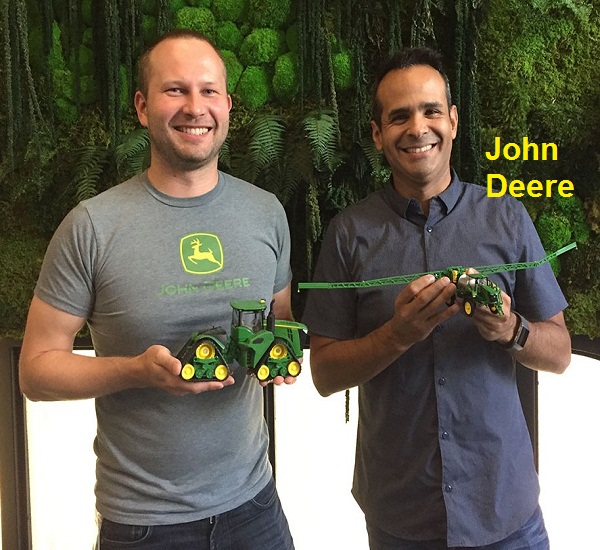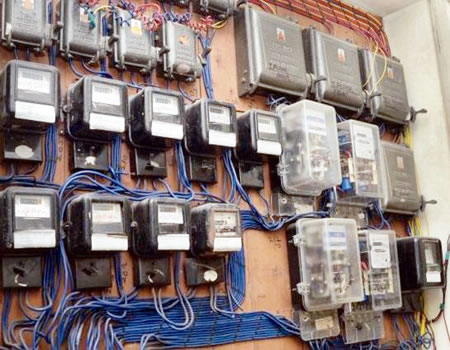What’s the world’s hardest machine learning problem? Autonomous vehicles? Robots that can walk? Cancer detection?
Nope, says Julian Sanchez. It’s agriculture.
Sanchez might be a little biased. He is the director of precision agriculture for John Deere, and is in charge of adding intelligence to traditional farm vehicles. But he does have a little perspective, having spent time working on software for both medical devices and air traffic control systems.
I met with Sanchez and Alexey Rostapshov, head of digital innovation at John Deere Labs, at the organization’s San Francisco offices last month. Labs launched in 2017 to take advantage of the area’s tech expertise, both to apply machine learning to in-house agricultural problems and to work with partners to build technologies that play nicely with Deere’s big green machines. Deere’s neighbors in San Francisco’s tech-heavy South of Market are LinkedIn, Salesforce, and Planet Labs, which puts it in a good position for recruiting.
“We’ve literally had folks knock on the door and say, ‘What are you doing here?’” says Rostapshov, and some return to drop off resumes.
Here’s why Sanchez believes agriculture is such a big challenge for artificial intelligence.
“It’s not just about driving tractors around,” he says, although autonomous driving technologies are part of the mix. (John Deere is doing a lot of work with precision GPS to improve autonomous driving, for example, and allow tractors to plan their own routes around fields.)
But more complex than the driving problem, says Sanchez, are the classification problems.
Corn: A Classic Classification Problem

One key effort, Sanchez says, are AI systems “that allow me to tell whether grain being harvested is good quality or low quality and to make automatic adjustment systems for the harvester.” The company is already selling an early version of this image analysis technology. But the many differences between grain types, and grains grown under different conditions, make this task a tough one for machine learning.
“Take corn,” Sanchez says. “Let’s say we are building a deep learning algorithm to detect this corn. And we take lots of pictures of kernels to give it. Say we pick those kernels in central Illinois. But, one mile over, the farmer planted a slightly different hybrid which has slightly different coloration of yellow. Meanwhile, this other farm harvested three days later in a field five miles away; it’s the same hybrid, but it also looks different.
“It’s an overwhelming classification challenge, and that’s just for corn. But you are not only doing it for corn, you have to add 20 more varieties of grain to the mix; and some, like canola, are almost microscopic.”
Even the ground conditions vary dramatically—far more than road conditions, Sanchez points out.
“Let’s say we are building a deep learning algorithm to detect how much residue is left on the soil after a harvest, including stubble and some chaff. Let’s drive 2,000 acres of fields in the Midwest looking at residue. That’s great, but I guarantee that if you go drive those the next year, it will look significantly different.
“Deep learning is great at interpolating conditions between what it knows; it is not good at extrapolating to situations it hasn’t seen. And in agriculture, you always feel that there is a set of conditions that you haven’t yet classified.”
A Flood of Big Data
The scale of the data is also daunting, Rostapshov points out. “We are one of the largest users of cloud computing services in the world,” he says. “We are gathering 5 to 15 million measurements per second from 130,000 connected machines globally. We have over 150 million acres in our databases, using petabytes and petabytes [of storage]. We process more data than Twitter does.”
Much of this information is so-called dirty data, that is, it doesn’t share the same format or structure, because it’s coming not only from a wide variety of John Deere machines, but also includes data from some 100 other companies that have access to the platform, including weather information, aerial imagery, and soil analyses.
As a result, says Sanchez, Deere has had to make “tremendous investments in back-end data cleanup.”
“We have gotten progressively more skilled at that problem,” he says. “We started simply by cleaning up our own data. You’d think it would be nice and neat, since it’s coming from our own machines, but there is a wide variety of different models and different years. Then we started geospatially tagging the agronomic data—the information about where you are applying herbicides and fertilizer and the like—coming in from our vehicles. When we started bringing in other data, from drones, say, we were already good at cleaning it up.”
John Deere’s Hiring Pitch
Hard problems can be a good thing to have for a company looking to hire machine learning engineers.
“Our opening line to potential recruits,” Sanchez says, “is ‘This stuff matters.’ Then, if we get a chance to talk to them more, we follow up with ‘Not only does this stuff matter, but the problems are really hard and interesting.’ When we explain the variability in farming and how we have to apply all the latest tools to these problems, we get their attention.”
Software engineers “know that feeding a growing population is a massive problem and are excited about the prospect of making a difference,” Rostapshov says.
Only 20 engineers work in the San Francisco labs right now, and that’s on a busy day—some of the researchers spend part of their time at Blue River Technology, a startup based in Sunnyvale that was acquired by Deere in 2017. About half of the researchers are focusing on AI. The Lab is in the process of doubling its office space (no word on staffing plans for that expansion yet).
Company-wide, Deere has thousands of software engineers, with many using AI and machine learning tools in their work, and about the same number of mechanical and electrical engineers, Sanchez reports. “If you look at our hiring 10 years ago,” he says, “it was heavily weighted to mechanical engineers. But if you look at those numbers now, it is by a large majority [engineers working] in the software space. We still need mechanical engineers—we do build green machines—but if you go by our footprint of tech talent, it is pretty safe to call John Deere a software company. And if you follow the key conversations that are happening in the company right now, 95 percent of them are software-related.”
For now, these software engineers are focused on developing technologies that allow farmers to “do more with less,” Sanchez says. Meaning, to get more and better crops from less fuel, less seed, less fertilizer, less pesticide, and fewer workers, and putting together building blocks that, he says, could eventually lead to fully autonomous farm vehicles. The data Deere collects today, for the most part, stays in silos (the virtual kind), with AI algorithms that analyze specific sets of data to provide guidance to individual farmers. At some point, however, with tools to anonymize data and buy-in from farmers, aggregating data could provide some powerful insights.
“We are not asking farmers for that yet,” Sanchez says. “We are not doing aggregation to look for patterns. We are focused on offering technology that allows an individual farmer to use less, on positioning ourselves to be in a neutral spot. We are not about selling you more seed or more fertilizer. So we are building up a good trust level. In the long term, we can have conversations about doing more with deep learning.”
Source: Spectrum










